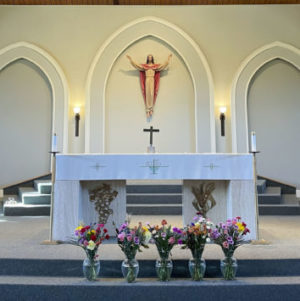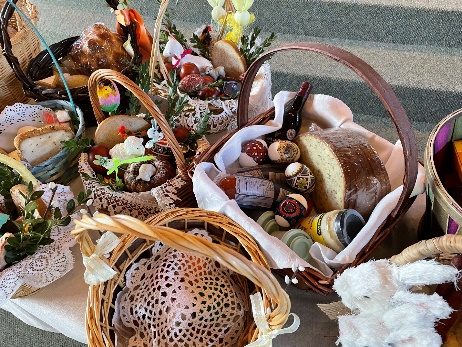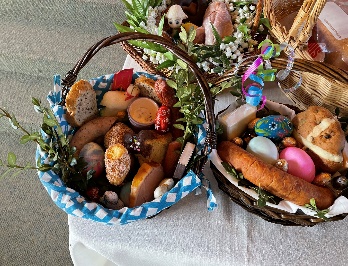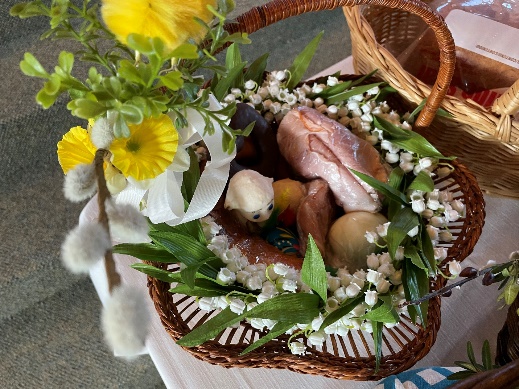
Blessing of the Easter Basket
(Easter Saturday Morning – 9:00 am)
In many Eastern European countries, it is a tradition to have a basket of food blessed on Holy Saturday. In Poland, for example, the blessing of the food basket has been part of its tradition and has been practiced since at least the fifteenth-century or earlier. The Holy Saturday blessing of the Easter basket remains a practice for most families in Poland to this present day.
Everything in the Easter basket has a special significance, and the blessed food is eaten at breakfast on Easter Sunday. While every family has its own traditions, yet there are some things about the Easter basket that are common to all.

Decorating the Basket
A lot of thought, time, and care are put into collecting and preparing the foods that will go into the Easter basket as well as its presentation. First, the basket is lined with an embroidered cloth or traditional folk fabric. The basket is filled, and then it is covered with a white linen cloth (some of the linen cloths have a colorfully crocheted edging or an embroidered design) representing the shroud of Christ. The basket itself is then ready to be decorated.
In rural Poland, for a woman, the size of the basket and what is placed in it is a matter of great pride (sometimes wooden bowls or even dresser drawers are used) and reflects her standing in the community.

Symbolic Foods
A variety of symbolic foods are placed in a typical European Easter basket, although families also personalize their basket to their liking. Within the blessing, there is a separate special blessing said for each: meat, eggs, cake, and bread, so baskets will most likely include these ingredients.
The basket might possibly include a little bird’s nest cake made with the leftover dough used for the figure of the lamb mentioned below, hard boiled eggs studded with cloves representing the nails of the cross, as well as sausages, ham, salt, and pepper. Also common are: horseradish, a figurine of a lamb made out of butter, or butter stuffed into a shot glass studded with a clove, and a small, round bakery rye bread topped with a paper decal in the shape of a purple cross. Some families will include greens, vegetables, and fruits in their baskets, but for other families they are never included.
- Bacon is a symbol of the abundance of God’s mercy.
- Bread is usually braided, representing the staff of life given by God.
- Easter bread is a round cake of rich, eggy yeast dough with raisins that is reminiscent of the Risen Lord.
- Butter is one of the dairy products included to celebrate the end of Lent and the richness of our Salvation. The butter is often shaped into a lamb, which is symbolic of the Paschal Lamb. Sometimes the lamb is made of dough, wood, or even plastic. It can also be made of sugar or chocolate.
- Candles symbolize Jesus, the “Light of the World,” and can be lit when the priest blesses the baskets of food.
- Cheese is a symbol to remind Christians of moderation.
- Colored eggs, as well as uncolored hard-cooked eggs, indicate hope, new life, and Christ rising from his tomb.
- Ham, as well as other meats, symbolize great joy and abundance in celebration of Christ’s Resurrection.
- Sausages are symbolic of the chains of death that were broken when Jesus rose from the dead, as well as of God’s generosity.
- Horseradish is a reminder of the bitterness and harshness of the Passion of Jesus, and the vinegar it is mixed with symbolizes the sour wine given to Jesus on the cross.
- Salt is present to add zest to life and preserve us from corruption.
- Sweets suggest the promise of eternal life or the good things to come.

Family Traditions
Although families often have their own traditions when it comes to the Easter basket, one surely observed is that the basket includes enough food so every family member can have a bite of all the blessed foods after Mass on Easter Sunday. This is a savoured sampling of the Easter dinner foods, and also included are some daily staples.